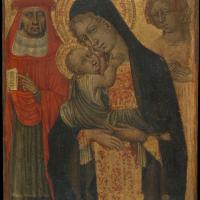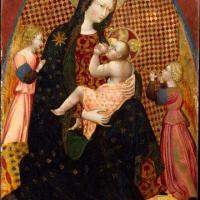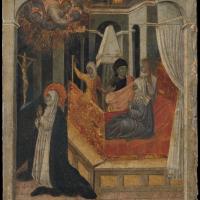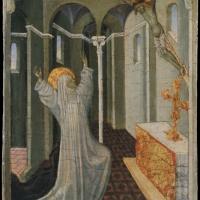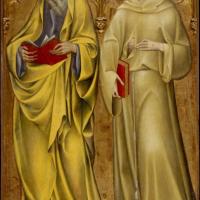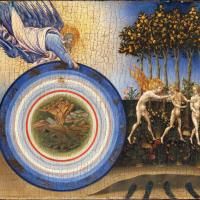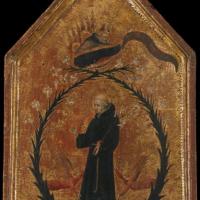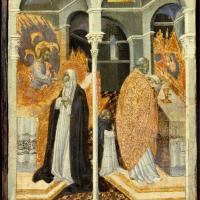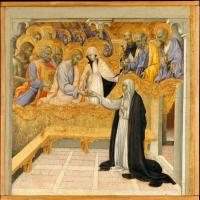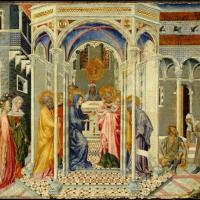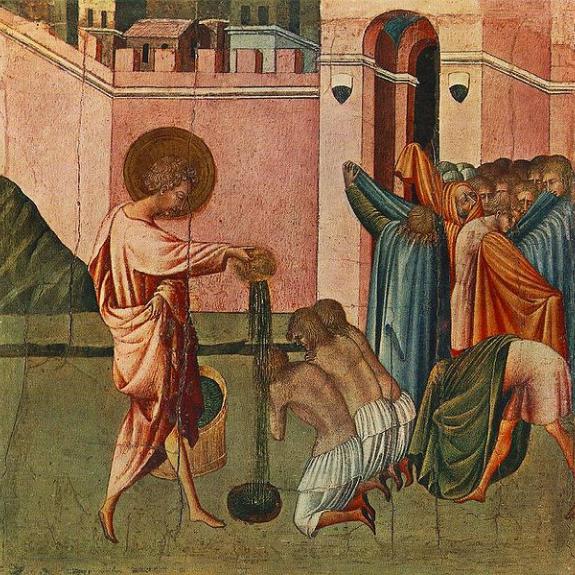Giovanni Di Paolo
Saint Ambrose
$480.00
Saints Matthew And Francis
$480.00
Giovanni Di Paolo
Giovanni Di Paolo (1403-1482)
Giovanni di Paolo di Grazia (1403–1482) was an Italian painter, working primarily in Siena. He may have apprenticed with Taddeo di Bartolo, becoming a prolific painter and illustrator of manuscripts, including Dante's texts.
He was one of the most important painters of the 15th century Sienese School. His early works show the influence of earlier Sienese masters, but his later style was more individual, characterized by cold, harsh colours and elongated forms. His style also took on the influence of International Gothic artists such as Gentile da Fabriano. Many of his works have an unusual dreamlike atmosphere, such as the surrealistic Miracle of St. Nicholas of Tolentino painted about 1455 and now housed in the Philadelphia Museum of Art, while his last works, particularly Last Judgment, Heaven, and Hell from about 1465 and Assumption painted in 1475, both at Pinacoteca Nazionale (Siena), are grotesque treatments of their lofty subjects. Giovanni's reputation declined after his death but was revived in the 20th century.
Giovanni di Paolo was first documented in 1417 working for the Sienese Dominican Order as a miniaturist (manuscript illuminator). Most of Giovanni's commissions came from local monastic communities which is apparent because so many of his early works are altarpieces for such churches. For example, The Virgin and Christ Child with Saints Bernardino, Anthony Abbot, Francis and Sabina and The Lamentation Over the Dead Christ (1462–3), a "square panel painting" altarpiece commissioned by Pope Pius II (of the noble Sienese Piccolomini family) for his recently finished cathedral.
Giovanni di Paolo was influenced by many great artists in Trecento and Quattrocento, Italy. It is believed that he may have owned a model book of other artists’ work he could flip through and use that would fit his paintings. A few of these include the following: Gentile da Fabriano's two Florentine altarpieces, Ambrogio Lorenzetti's Presentation in the Temple, and the Baptistery reliefs by Donatello. He would then be able to alter, modify, and combine these artists’ works into his own renderings. Throughout his career one can see how this model book was utilized because of certain figures he repeatedly used, "His isolated detail, a single figure, or group copied from another image is shown that he is naturally drawn to the inventions of his fellow artists". However much it would be looked down upon today to copy, in Trecento and Quattrocento Siena, the culture valued an artist that could manipulate others' work and make it their own as creatively as Giovanni did.
Giovanni di Paolo was influenced by many artists during his time, which can be seen in a number of his paintings. Giovanni's Raising of Lazarus is based on the same scene of Duccio's Maestà. "But where Duccio's figures are sober and restrained, Giovanni di Paolo's are voluble and animated". Giovanni was open to solutions other than the Sienese tradition which, "...made him receptive to sources farther afield as well". One of these is the occasion where he painted a picture he had drawn from a mural in Assisi".mHis work and style show the transition from the Sienese and Gothic style into the Renaissance.
His style also took on the influence of International Gothic artists such as Gentile da Fabriano. He was an artist of great consequence who had been invited by Pope Martin V to Rome. On his way to Rome, Gentile stopped in Siena, where Giovanni quickly assimilated Gentile's techniques. One technique he kept was Gentile's fascination with nature. Instead of using standing saints, as was customary, in his painting Giovanni used sprigs of flowering plants.
Giovanni di Paolo's Adoration of the Magi and Gentile da Fabriano's Adoration of the Magi are one example of how nature was used by both artists and how Giovanni was able to create the same use of animals and plants from Gentile and make it his own. Where Gentile was capable of darkness and mystery, Giovanni, "...saw nature as untarnished and ever-benign". These works of art that Giovanni integrated into his own were, "...waiting to be imbued with personal meaning" a creation Giovanni was able to do well.
Later in his life Giovanni became greatly skilled at painting illuminated manuscripts, he illuminated choir books for the Augustinian monks at Lecceto as well as Dante's Divine Comedy. The illuminations that he created for Dante's poem are some of his most famous and best preserved works. His illuminations are one area viewers can see how Giovanni di Paolo differentiates himself from other Sienese artists. He may have been in contact with Franco-Flemish illuminators, who had been in Siena during Giovanni's early years. It seems their Northern influence may have rubbed off on Giovanni because his landscapes resemble those in the famous painting by the Limbourg brothers; Tres Riches Heures. His suspected master, Taddeo di Bartolo, probably taught him how to paint with a "toughness of line", which can be seen in any of his works. The most striking quality of Giovanni di Paolo's work is the fantastical quality. John Pope-Hennessy explains Giovanni di Paolo's work eloquently, "Few experiences in Italian painting are more exciting than to follow Giovanni di Paolo as he plunges, like Alice, through the looking-glass. If one looks at the Madonna of Humility (1435) the checkerboard landscape confirms the world beyond the garden scene in the foreground (also referred to as the hortus conclusus). This checkerboard panorama effect is used frequently by Giovanni for its ability "to create an abstraction of space, whose appeal is not to the fixed optic of the spectator, so much as to the winged flight of the dream-voyager." .




